Broken Hill (wikipedia)
is an isolated mining city in the far west of outback New South Wales, Australia. The world’s largest mining company, BHP Billiton, has roots in the town. Broken Hill is located near the border with South Australia on the crossing of the Barrier Highway (A32) and the Silver City Highway (B79), in the Barrier Range. It is 315 m (1,033 ft) above sea level, with a hot desert climate, an average rainfall of 235 mm (9 in). The closest major city is Adelaide, the capital of South Australia, which is more than 500 km (311 mi) to the southwest. Unlike the rest of New South Wales, Broken Hill (and the surrounding region) observes Australian Central Standard Time (UTC+9:30) a time zone it shares with South Australia and the Northern Territory. Broken Hill has been referred to as “The Silver City”, the “Oasis of the West”, and the “Capital of the Outback“. Although over 1,100 km (684 mi) west of Sydney and surrounded by semi-desert, the town has prominent park and garden displays and offers a number of attractions such as the Living Desert Sculptures. Town name Broken Hill is Australia’s longest-lived mining city. In 1844, the explorer Charles Sturt saw and named the Barrier Range, and at the time referred to a “Broken Hill” in his diary. Silver ore was later discovered on this broken hill in 1883 by a boundary rider named Charles Rasp. The “broken hill” that gave its name to Broken Hill actually comprised a number of hills that appeared to have a break in them. The broken hill no longer exists, having been mined away.The area was originally known as Willyama. Before Charles Sturt’s naming of the town, the surrounding area was referred to by the local Aboriginal population as the “Leaping Crest Geology Broken Hill’s massive orebody, which formed about 1,800 million years ago, has proved to be among the world’s largest silver–lead–zinc mineral deposits. The orebody is shaped like a boomerang plunging into the earth at its ends and outcropping in the centre. The protruding tip of the orebody stood out as a jagged rocky ridge amongst undulating plain country on either side. This was known as the broken hill by early pastoralists. Miners called the ore body the Line of Lode. A unique mineral recently identified from Broken Hill has been named Nyholmite after one of the city’s famous sons Ron Nyholm (1917–1971). Lead with the isotope signature of the Broken Hill deposits has been found across the entire continent of Antarctica, in ice cores dating back to the late nineteenth century.
History The earliest human settlers in the area around Broken Hill are thought to be the WiljakaliAborigines, although originally thought to be intermittent, owing to the lack of permanent water sources, it has since been found that the Indigenous Clans of the area were able to survive on underground water holes and wells that were unknown to the European settlers. Many of these waterholes are still kept secret from non-Indigenous people. As in much of Australia, a combination of disease and aggression by white settlers drove them from their lands. The first European to visit the area was the then Surveyor General of New South Wales, Major Thomas Mitchell, in 1841. Three years later, in 1844, the explorer Charles Sturt saw and named the Barrier Range while searching for an inland sea; the range was so named as it was a barrier to his progress north. Burke and Wills passed through the area in their famous 1860–61 expedition, setting up a base camp at nearby Menindee. Pastoralists first began settling the area in the 1850s, with the main trade route to the area along the Darling River. Broken Hill was founded in 1883 by boundary rider Charles Rasp who patrolled the Mount Gipps fences. In 1883 he discovered what he thought was tin, but the samples proved to be silver and lead. The ore body they came from became the largest and richest of its kind in the world. The Broken Hill Proprietary Company (BHP) (later BHP Billiton) was founded by the Syndicate of Seven to mine the ore body of Broken Hill in 1885. By 1915 BHP realised its ore reserves were limited and began to diversify into steel production and on 28 February 1939 mining at the BHP mines at Broken Hill had ceased. BHP was not the only miner at Broken Hill, and mining continued at the southern and northern ends of the Line of Lode. Currently the southern and northern operations are run by Perilya Limited who plan to open further mines along the Line of Lode. The Battle of Broken Hill took place on New Year’s Day 1915 when two Afghani men fired upon a trainload of people who were headed to a New Years Day picnic. Since, at that time, Australia was at war with the Ottoman Empire, those people were first speculated to be Turkish, but later identified as being from British colony of India (modern day Afghanistan). They killed four and wounded six, before they were killed by a group of policemen and soldiers. In 1918 the Italian Ambassador to Australia, Emilio Eles, with the help of the Australian police and the army organized the rounding up of Italian deserters, working there as miners, to be forcibly sent back to Italy to fight in the war. It is also known for its input into the formation of the labour movement in Australia, and has a rich trade union history. Some of the most bitter industrial disputes have been fought in Broken Hill in 1892, 1909 and 1919. The last of these led to the formation in 1923 of the Barrier Industrial Council, a group of 18 trade unions, which became one of the most influential organisations in the politics of the city. Like many “outback” towns, Broken Hill was built on precious metals, having once had the world’s richest deposits of lead, zinc and silver. Although now depleted somewhat, mining still yields around two million tonnes annually. Some mine tours are available. Sheep farming is now one of the principal industries in the area and there are considerably more sheep than people — almost 2 million Merino sheep. On 10 January 2007, the Broken Hill City Council was dismissed by the New South Wales Minister for Local Government following a public inquiry.
12th January, Monday
Well, here are again in the outback, anybody would think we loved it because we keep coming back for more. We left Mildura early as it was a long haul for us (300kms HAHA). The road to Broken is pretty much outback, flat, low scrub, lots of goats, the odd few emus and not much else. It still has its own beauty though so don’t think that it’s boring. We had 300kms of not much traffic, we only saw one other caravan coming in the opposite direction and maybe 3 or 4 road trains and a few cars. There are no towns from Mildura to Broken Hill, one road house half way and that’s it. The road itself is not that wonderful, once you cross from Victoria (good roads) into New South Wales the quality of the roads gets downgraded pretty quickly, Strange how the roads change from state to state and how noticeable it is once you cross state boundaries. We arrived in Broken Hill before lunch because we forgot that we had to change our time and go back half an hour because although Broken Hill is in New South Wales they are on South Australian time????? Vic and Sue were already at the caravan park and it’s so nice to catch up with them. We had a few drinks and some nibblies for lunch and the boys headed off to sort Vics Satellite dish out and Sue and I jumped into the pool as it’s really muggy and warm today. Quite a few of the people in this caravan park are on their way to Tamworth for the music festival (as are Sue and Vic). Sue and Vic cooked an awesome roast for us and we hit the sack pretty early, all tired old farts. It’s pouring tonight and the locals are so happy as they don’t get much rain in this part of the world and we don’t mind the rain. We plan on spending about 2 weeks here as there is so much to see and do here, lots of fossicking for Ralph and there are 12 art galleries here, one of them is a Pro Hart gallery and I love his work, if only I could win lotto and buy one of his paintings. His daughter is also an artist but I don’t know her work and she has a studio here as well so I can’t wait to see her work and get a bit of art culture. Sue and Vic leave for Tamworth on Wednesday as I suppose will the other half of the park.
History of Silverton (Information sourced from “Silverton”, by RHB Kearns). In the 1880s, the Barrier Rangers were alive with activity. Mining claims sprung up as pioneers arrived to seek their fortune in the outback earth. Established in 1880, Silverton was the area’s largest township as it offered a central, flat position and a water supply. Originally called Umberumberka after the nearby township from which it was considered an offshoot, Silverton was truly born in 1883 when its name was proclaimed and it received a post office in 1883. At that time, Silverton boasted a population of 250, but in a matter of months that number had doubled. Within two years, 3,000 people had set up shop in Silverton – the peak of the township’s population. Once Silverton was established, it quickly began to flourish, with businesses, medical practitioners, solicitors, and entrepreneurs of every type springing up to line the streets. The Silverton Municipal Council was formed in 1886 and held its inaugural meeting the following January. As the town grew, the traditional methods of transport – wagons drawn by animals – had been all but exhausted. It became apparent that a railway line would be of benefit. While the South Australian Government constructed a line as far as the border, the NSW Government declined to extend the line through their territory. Thus, the Silverton Tramway Company – locally and privately owned – was formed to build and operate the line. It was opened in 1888 and ran from Cockburn, through Silverton and on to the newly discovered Broken Hill. The line functioned up until 1970, having transported 57 million tonnes of freight and 2,881,000 passengers, when trains were re-routed at Cockburn to bypass Silverton. In its heyday Silverton boasted every convenience, including a newspaper, Masonic Lodge, goal, gymnasium, hospital, jockey club, football team and Methodist Church. The trade union movement, popularised by its successes in Broken Hill, originated in Silverton in 1884. Formed at a public meeting, the Barrier Ranges Miners’ Association was a friendly society aiming to assist those injured in a mining accident. In 1886 the association resolved to form a branch of the Amalgamated Miners’ Association of Australasia. They pushed for workers’ rights under the banner “United we stand, divided we fall”, and unionism was born in the region. That wasn’t the only thing to happen in Silverton that would have repercussions farther a field. The Broken Hill Proprietary Company Limited (BHP Billiton) was formed in the then-Silverton Hotel in 1885. The company would have a huge impact upon the country’s mining industry and the State’s finances for generations. Ironically, the region’s rich mineral deposits that Silverton was built upon were also the cause of its eventual decline, as larger mines sprung up in nearby Broken Hill. The Municipal Council was taken off the NSW state register in 1899, leaving the State Government in control of the town, and many of its buildings were transported into Broken Hill by teams of donkeys, camels or bullocks. Although less than 60 people live in Silverton today, the town has enjoyed a new life. It is now managed by the Silverton Village Committee, which includes locals and Government representatives. Although few buildings remain, the culture remains vibrant. The same landscape that was once home to a legion of miners is now inspiring a new generation of artists. Its rich history and art galleries attract people from all over the world. The unique land and light has led to Silverton being immortalised on both television and the movie screen. Mineral wealth may have moved on, but Silverton is now richer than ever before
. 13th January, Tuesday
It rained all night last night. They haven’t seen rain in this part of the world for a long time and now they are getting a deluge. I started the morning off by going to water aerobics with Sue and I am now feeling virtuous, HA. We went to Silverton today which is about 25kms from Broken Hill and is an old mining town. The building today are just shells but the history of the place is so rich. The road to Silverton has been washed away in parts because of the heavy rains in the past few days and at some spots we thought that we might not get through as we weren’t sure of the condition of the road under the water. The owner of the pub in Silverton came out and said that the road really should have been officially closed. Silverton is a common so the animals (donkeys, horses, cattle, whatever) are allowed to roam free, much like Sapphire. When we got there the donkeys were all in front of the pub and they decided that they wanted to check Hugo out. Hugo had a sniff, a look and decided that they weren’t for him. Ralph trotted off with Hugo and poor Hugo couldn’t get away quick enough. He was pulling Ralph on the lead and he just wanted to get back into the car, poor Hugo wasn’t happy. Mad Max was filmed here as was some parts of Priscilla queen of the dessert. We will come back to take more photos on another day as some of the roads are closed. The art galleries too were closed as we think that they thought that the road was closed and no tourists were going to be able to get through. I must admit though that the place wasn’t very busy. We had a couple of drinks at the pub and were accosted by the donkeys, well, let’s say that I was accosted by one particular donkey who took a shine to me. Poor Hugo went and hid under the table between Ralph and Sue where he felt safe. This donkey started to nibble my shoulder and then proceeded to try and take a nice chunk out and then he went on to my hair and tried to pull my hair clips out and then took a nice bite of my scalp. My hair was covered in donkey spit EISH. We came back to camp, did some shopping and then had dinner with Vic and Sue. They are leaving for Tamworth in the morning. It was so nice to see them and catch up. They are off to Tasmania after Tamworth and we are so jealous. That will be another trip for us. We were told today by the bar lady in Silverton that if they don’t get more rain soon the town is going to dry up completely and they don’t know what they will do about that, so let’s hope for their sake that it is going to rain some more.
- Welcome to Broken Hill
- Sunset
- Children playing at the road crossing in the flood waters
- The crossing, not as bad as it looks
- Vic and Sue
- Us, Vic and Sue on the other side
- Vic and Sue
- Our donkey friends
- Donkey and a mad max car at the Silverton hotel
- Not sure what you are
- A mexican stand off
- Hugo trying to get away from the donkey and they kept following him
- Silverton
- Silverton
- Silverton
- Mad Max
- Silverton
- Mad Max
- Mad Max
- Mad Max
- Silverton ruins
- Mad max
- Silverton
- Silverton
- Silverton
- Silverton
- Silverton
- Silverton
- Silverton
- Silverton
- Silverton
- Silverton
- Silverton
- Ralph, Sue and Vic at the Silverton Hotel
- Ralph, SUe and Linda at the Silverton hotel
- Our donkey friends again
- Poor Hugo
- Our donkey friends
- Our donkey friends
- My new pal
- My new pal, steady on, I got a good chew on the shoulder and then one on the head
14th January, Wednesday
Sue and Vic left early this morning and then I went to the aquatic centre for my water aerobics. The weather this morning was very pleasant, not too hot and not too cold, it did start getting warmer after lunch though but not too bad. We didn’t do much today, so I don’t have much to tell you.
15th January, Thursday
Old virtuous one got up early again this morning and hit the pool, actually it’s good fun and I’m really enjoying it. We went to visit Pro Harts art gallery today. Pro Hart was born and lived in Broken Hill and we have been long time fans of his paintings. He was considered the father of the outback painting movement. His daughter “Julie” is an artist as are his other children but Julie has a gallery just up the road from the caravan park. Her gallery was closed today but he will pop in again sometime. I was wrong about there being 12 art galleries here, there are actually 20. We popped into the information centre after that to get some more info of the area and then back to the caravan park. Tomorrow we might go back to Silverton. At about 10.30 last night there was a gun shot very close to the caravan park and then a car speeding away. I mention this to the lady in the Pro Hart gallery and she said that it was normal for this part of the world.
- Pro Hart gallery
- One of Pro Harts Rolls Royces (this one he has painted)
- One of Pro Harts Rolls Royces (this one he has painted)
- An old abandoned church in town
16th January, Friday
Not much to tell you for today folks. Ralph went off to see a few mining museums where some gems and rocks were displayed and to get some info of where he can fossick. He was only gone until Lunchtime and Hugo and I stayed at home and I practised my painted. Other than that it was a pretty much uneventful day.
17th January, Saturday
It’s starting to warm up again so we took off early for Silverton to see the art galleries, history, mines etc. We visited quite a few art galleries and I love the art that these guys do. We got chatting to one of them in his studio and couldn’t get away, he was such a character and used to be an underground miner in Silverton so he was telling us all the history and how the guys used to be killed etc. sad really. He is a brilliant artist, we love his works and we bought one of his signed prints, wish that we could have afforded to get an original, never mind I will paint one (HAHAHAHA). The donkeys were about town again and we got out the car to take a picture of one of the old churches and as we looked back there was a donkey giving Hugo a how’s your father through the car window. Poor Hugo wasn’t happy as he thought that he was in home base and how dare the donkey invade it, we had donkeys putting their heads through all the windows when we got into the car, it was very funny so check out the photos. We drove out to Mundi Mundi where part of Priscilla queen of the desert was filmed. From the lookout the landscape is quite barren and it was very windy, very much desert conditions. From there we drove to Umberumerka reservoir and in the middle of the road to the reservoir was a turtle heading off to the water. It was quite bizarre seeing this in the middle of the desert. The reservoir is there for the town people but it’s not very full and the water looks quite muddy but I guess that the turtle didn’t mind. After that we drove to Umberumerka Mine which was the first silver mine in this area and was mined eventually by BHP. The mine is now abandoned and Ralph was looking for possible fossicking areas. He will come back here tomorrow and see what he can find (there is no stopping the boy). I will stay at home and practise my painting again. We had lunch at the pub and on the way back stopped at the pioneer cemetery. This is an old pioneering cemetery. Quite a few of the graves are quite sad as they are not marked as quite a few of them were miners on their own and also poor mining families couldn’t afford headstones. A lot of them were children as conditions here were really harsh. You can just make out the graves that aren’t marked as the ground is slightly raised and you have to be careful where you walk as they are all overgrown with low scrub. Silverton have a few derelict and broken down Cornish cottages, although there is still one standing. Most of the miners that came out here in the 1800’s came from Cornwall as Cornwall was also a mining area. Back to town and some food shopping and then back to base.
- Mundi Mundi Plains where the desert scenes of “Priscillas Queen of the desert” where filmed
- Mundi Mundi Plains
- Mundi Mundi Plains
- A turtle on his/her way to the reservoir
- I see you, so cute
- Umberumberka resevoir
- Umberumberka reservoir
- Mundi Mundi plains
- an old Cornish cottage
- an old Cornish cottage
- an old Cornish cottage
- an old Cornish cottage
- an old Cornish cottage
- The only Cornish cottage still standing
- The only Cornish cottage still standing
- Umberumberka mine
- Umberumberka mine
- the view from Umberumberka mine
- In front of an artist studio
- An artists joke
- Silverton town
- An old church circa 1885
- St. Carthage Catholic church circa 1886
- Poor Hugo being harrassed by this donkey, I think that this donkey was in love
- Poor Hugo being harrassed by this donkey, I think that this donkey was in love
- They love us
- Another art gallery with a painted dunny
- Justin Cowley art gallery
- Justin Cowley art gallery
- Silverton Botanical weed garden
- Silverton
- Municipal chamber Silverton
- An old residence
- Scouts hall
- The Pioneering cemetery – Silverton
- The Pioneering cemetery – Silverton
- The Pioneering cemetery – Silverton
- The Pioneering cemetery – Silverton
18th January, Sunday
Ralph went fossicking this morning and then to a mining museum where you go underground and as I have told you all before that going into the depths of the earth is not for me I stayed behind with Hugo. There is not much to find here, well, not much in the shape of gemstones. Ralph go back about midday and another veg out afternoon.
19th January, Monday
We did a rekkie of Broken Hill today. The inner suburbs are old, old houses, old semi detached places which we think were probably accommodation for mining families, although they are very old they are all still inhabited. A great portion of the old houses are made from corrugated iron and they are also still inhabited by families. This is not a wealthy town, very much middle class and although it’s a big place people are very friendly and accommodating. We haven’t seen any swish expensive houses but that’s not to say that they aren’t here as we have just visited the old parts of the town and the people that we are interested in, the real Broken Hill residents. Artists (as I mentioned before) are prolific here and we have done our fair share of art galleries, all amazing and all are wonderful artists. I went into an art shop to buy a couple of paints and a couple of brushes that I needed and they had hardly any stock on their shelves, I found this quite amazing considering the town that we are in, I think that perhaps the artists here might buy their art supplies on line or do a big trip to Melbourne or Sydney now and then to stock up. We (or should I say “I”) did my rekkie of all the old historical buildings around town. Ralph took his book and he and Hugo sat in the car while I toured the place with my camera in tow. Ralph reckons that he is all museumed out and I suppose I am all art galleried out. We treated ourselves and had breakfast at one of the little coffee shops in town. We visited the mining memorial which is situated on top a tailings dump next to a disused open cut mine. It’s a sad place as there are ornamental roses on poles and each rose has the name of a miner who died doing his job, there are so many roses. From there we visited another art gallery which is reputed to house the largest painting on canvas in the world. It’s an acrylic painting called the “The big picture”, it’s 100m long and over 12m wide, painted with 9 tonne of paint. It took the artist (Peter Anderson a local artist) 2 years to paint and is really something to see, it’s magnificent. We decided not to stay for the full 2 weeks as we originally intended to do. We feel that we have seen most of the sights and have had heaps of days doing nothing so feet have started itching and are eager to move on to the next place. We have booked in for an extra 2 nights and have been here for 1 ½ weeks which has been a good relaxing stop for us and Broken Hill has so much to offer so you really can’t rush it. We have decided to head for Hawker from here which is in South Australia and part of the Flinders Rangers. Tomorrow we will visit the last few things that we want to see.
- Broken Hill
- Broken Hill
- Broken Hill
- Sabey & Co
- Argent Street – Broken Hill
- Argent Street – Broken Hill
- The miners memorial
- Broken Hill – a view from the miners memorial
- Broken Hill – a view from the miners memorial
- This is still a working mine
- This is still a working mine
- This is still a working mine
- Art Gallery
- Argent Street – Broken Hill
- Broken Hill
- Broken Hill College
- Carrington Hall
- These are little dug out boats outside the court house
- The Court House
- Argent Street
- This is the front of the dug out canoe which is in front of the court house
- The miners memorial
- The miners memorial
- The miners memorial – each rose has a name against it for a miner who lost their life
- The miners memorial – each rose has a name against it for a miner who lost their life
- Miners memorial
- The Palace Hotel
- The Post Office
- Royal exchange hotel
- The social democratic club
- Sulley building
- The Astra Hotel
- Theatre Royal Hotel
- The town hall
- The trade hall
- Vietnam vets memorial
- Working mens club
- Working mens club
20th January, Tuesday
We didn’t do anything today apart from a bit of shopping and taking the car to the car wash to wash all the mud off from the trip we did to Silverton. Today Broken Hill made Australian History by becoming the only complete city in Australia to be put on the Heritage list and we were here for that bit of history. We are wondering if our caravan is now heritage listed? (HAHA).
21st January, Wednesday
Today is our last day in Broken Hill as we head off for Hawker in South Australia tomorrow morning, the weather is starting to hot up again and we have been very lucky with the unseasonal cool weather. We have loved being in Broken Hill and this place would have to be up there with one of our top spots to visit. We spent our last day visiting Julie Hart’s (Pro Hart’s daughter) art gallery. She is very much as talented as her late father and you can see that the apple didn’t fall too far from the tree. We bought a print of one of her paintings which she signed for us, so wish that we could have bought an original as her paintings really are beautiful. We did a few last minute things and then back to base to start packing up etc. I had to give all our fruit, veg and honey away as we can’t take fresh produce over to South Australia. I made a huge stew though which I can freeze and it will give us a few meals, so from Broken Hill, cheers for now. xx
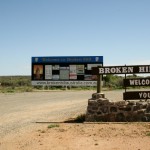
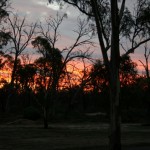
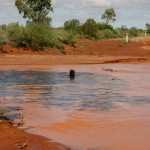
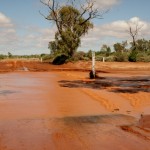

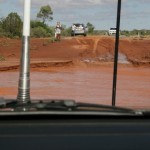
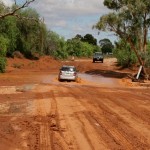




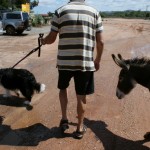



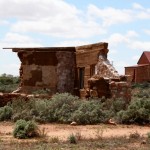
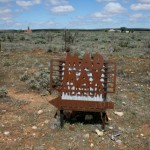
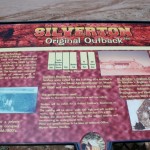
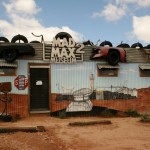
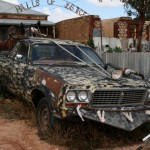

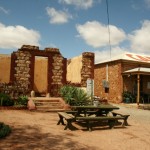
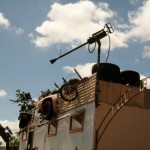


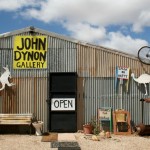
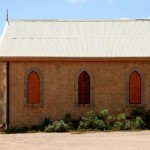


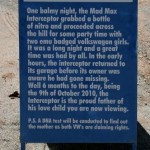
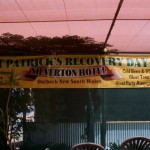

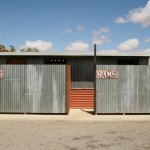
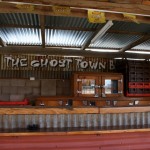
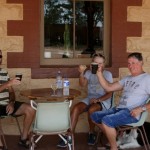

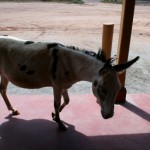

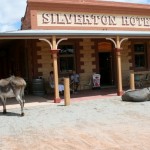
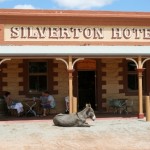

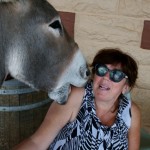
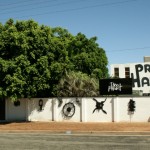





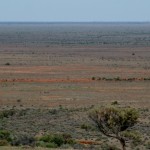

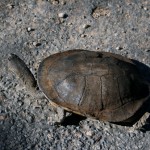


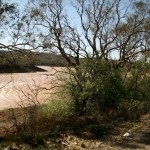

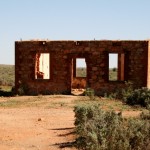




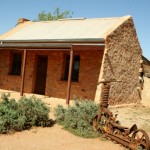
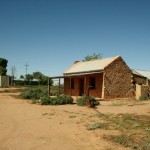



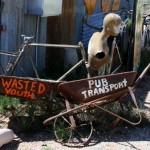
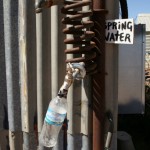
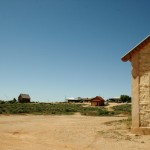
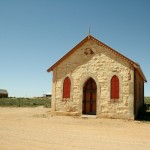

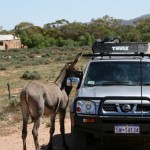
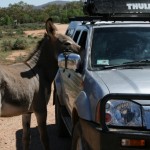
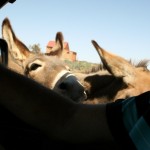
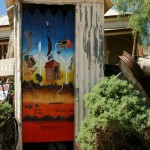
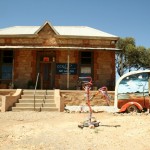

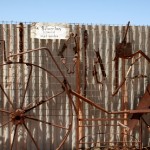
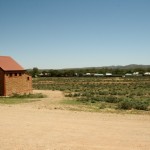
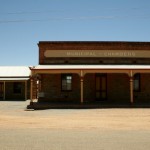
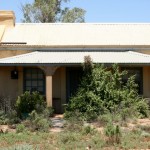


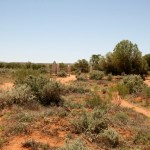

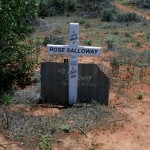
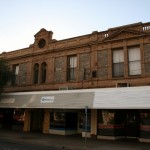

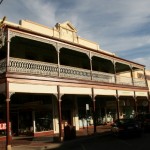
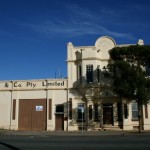


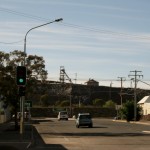
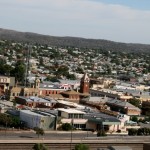


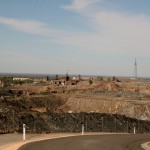

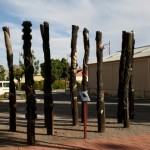
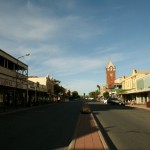

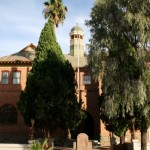
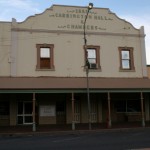

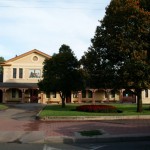
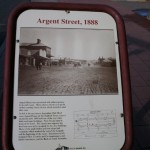
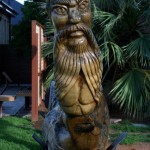


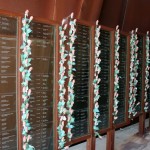
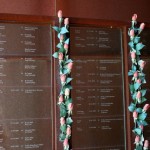
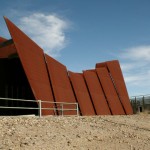
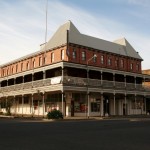
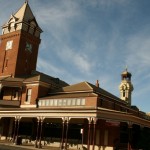
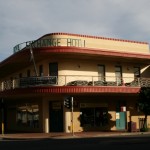
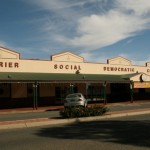
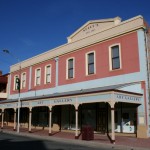
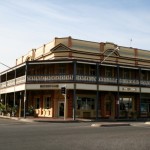

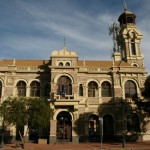


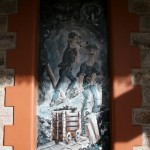
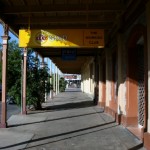
Must be a good spot there for you to stay 2 weeks. I bet you’re lovin the rain. I’ve just got back from a few days in Melbourne and it was cool weather with some rain – beautiful!! Bloody hot in Perth this week 🙁 lotsa love to you and Ralphie. Xxxxx
So glad you are enjoying broken hill. how is Higo recovering from the donkeys?
The donkeys had a go at him again today. This time he was sitting in the car minding his own business. x